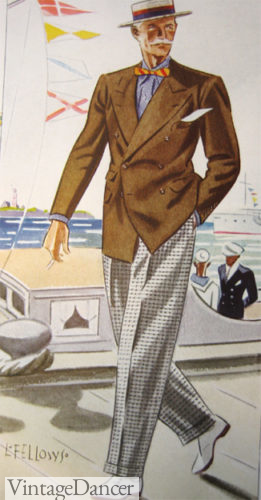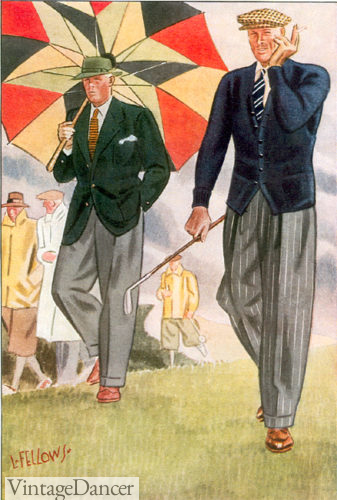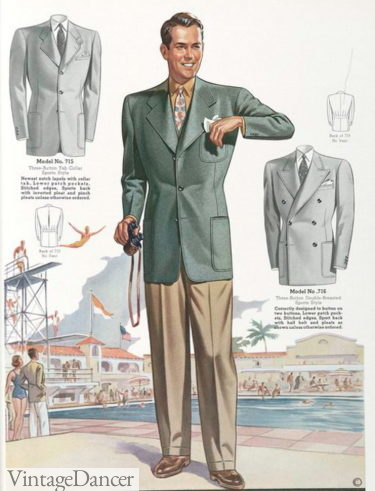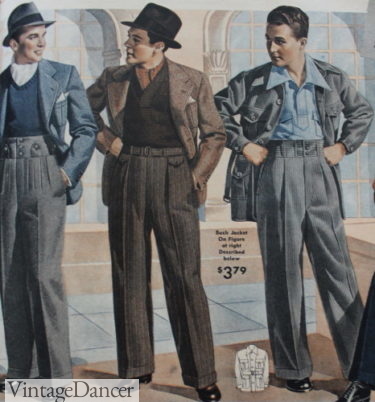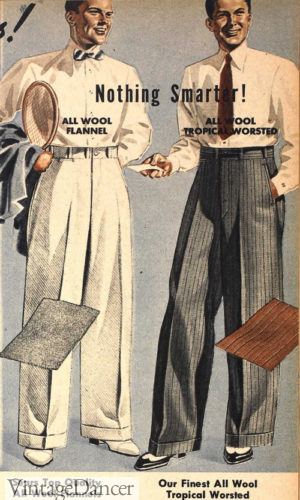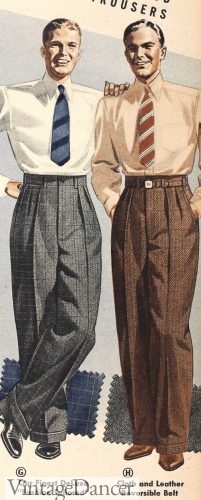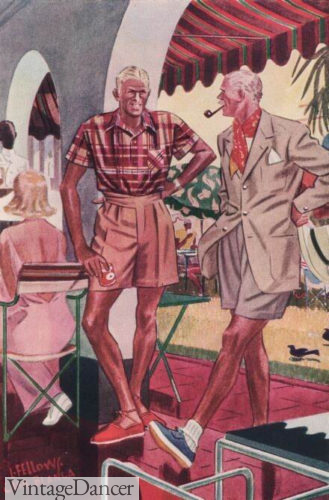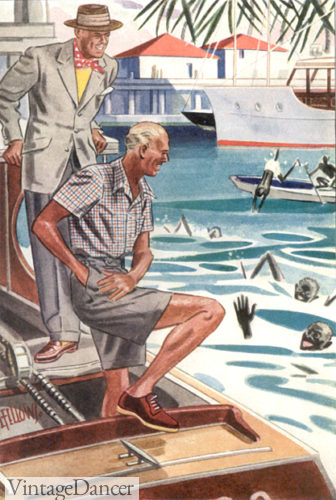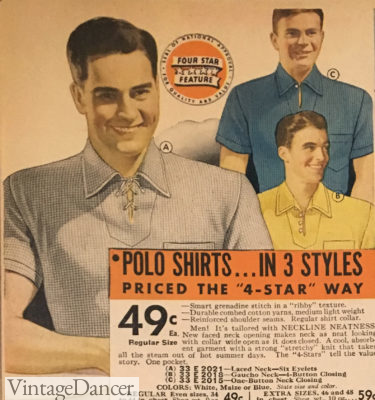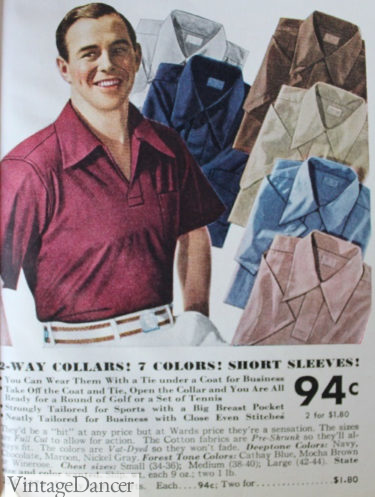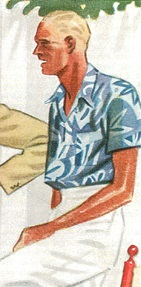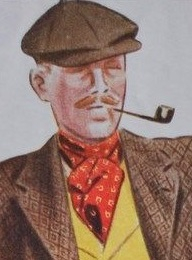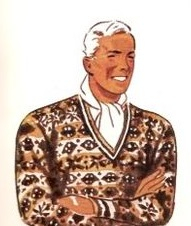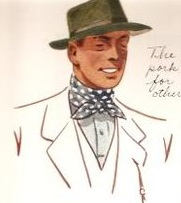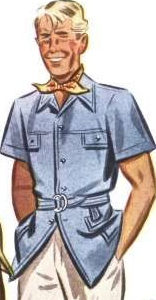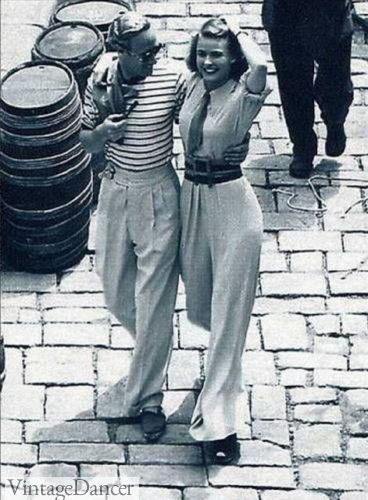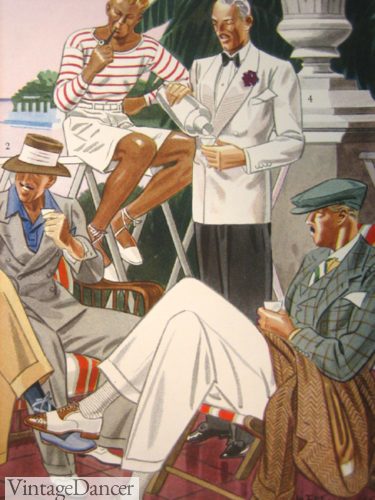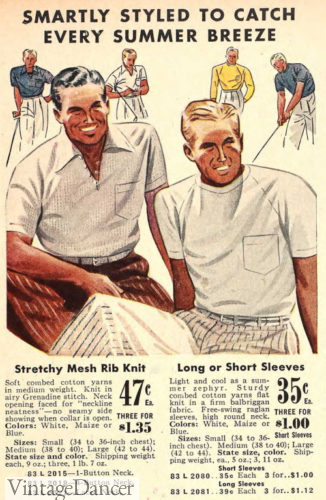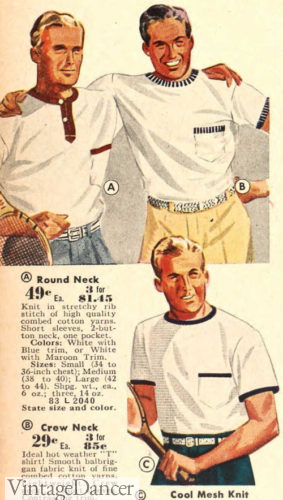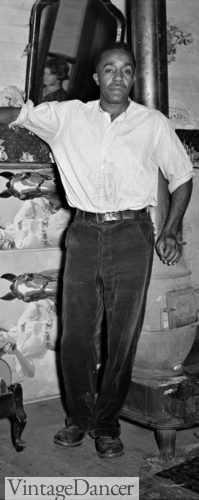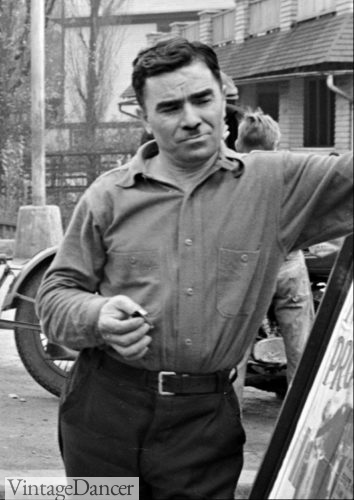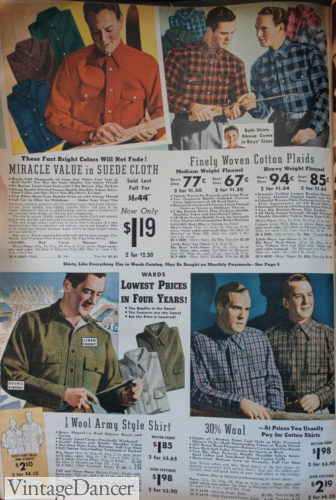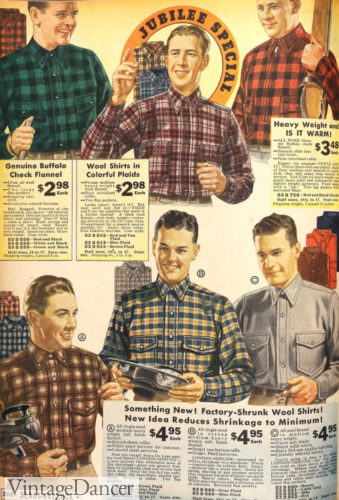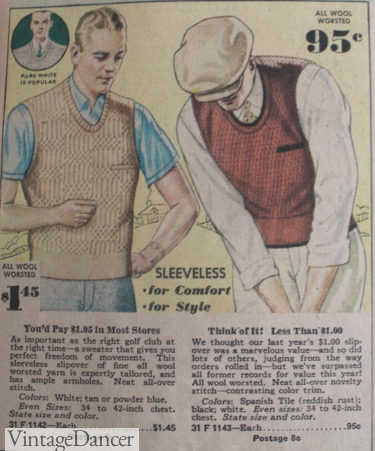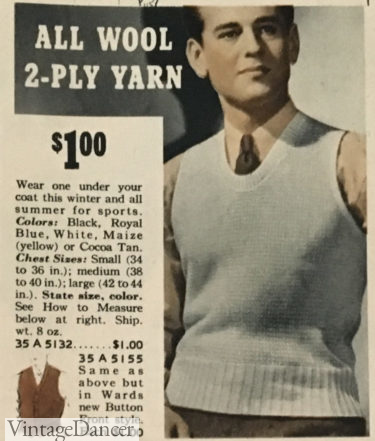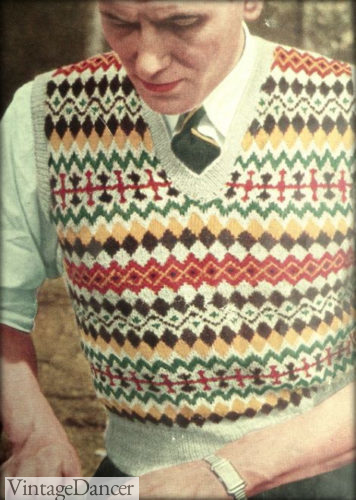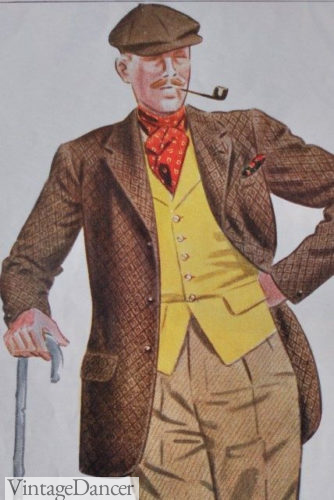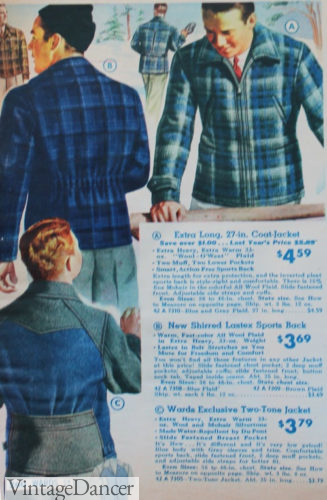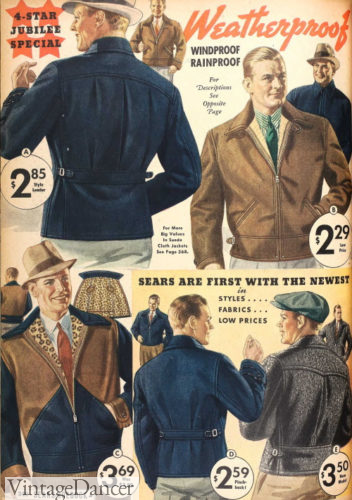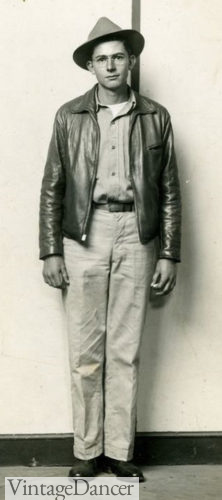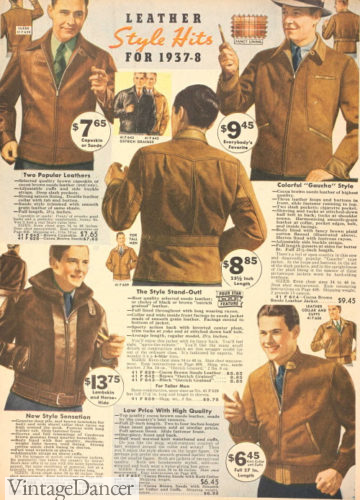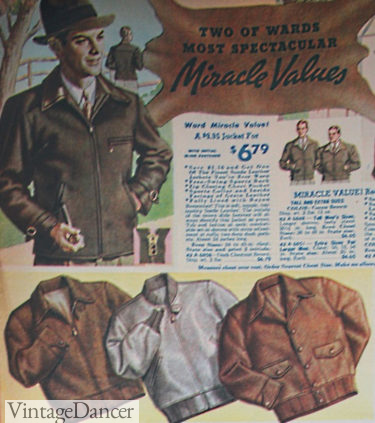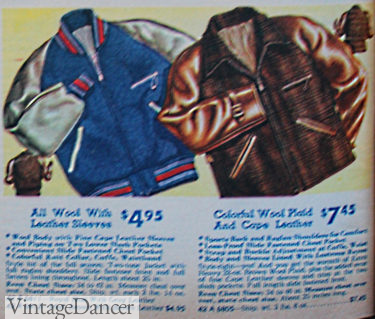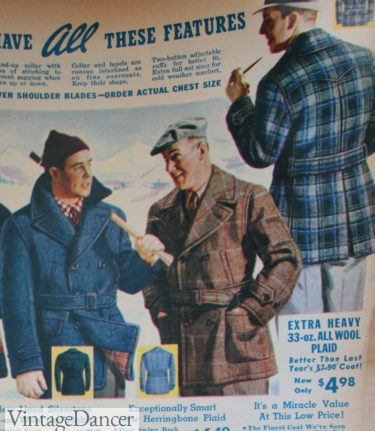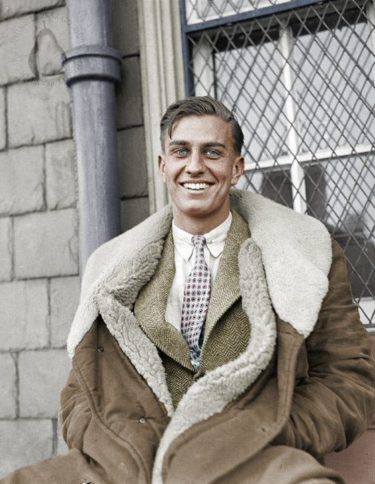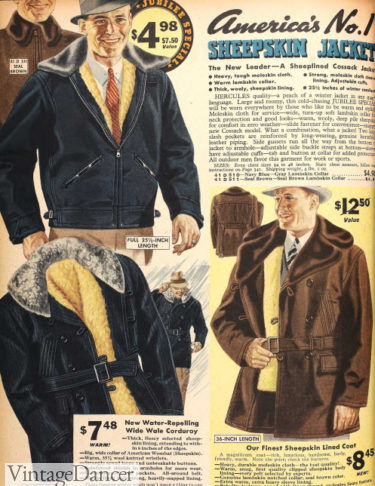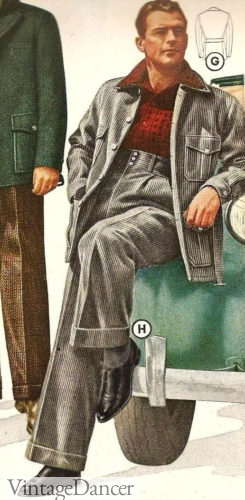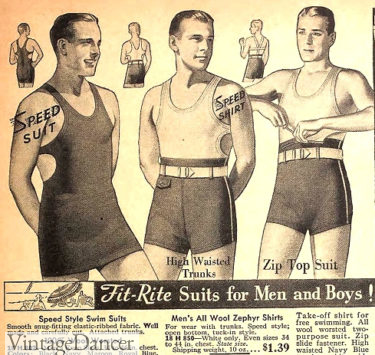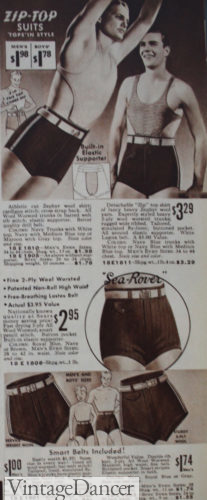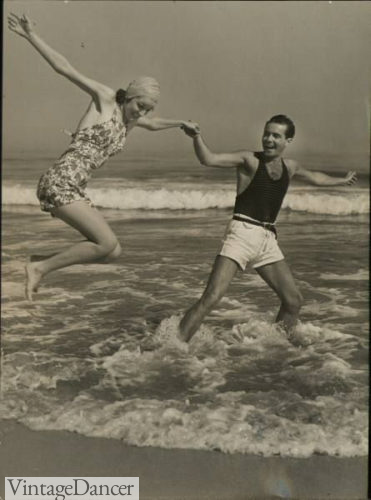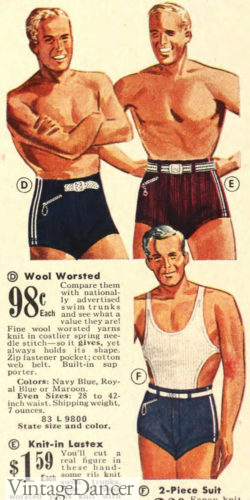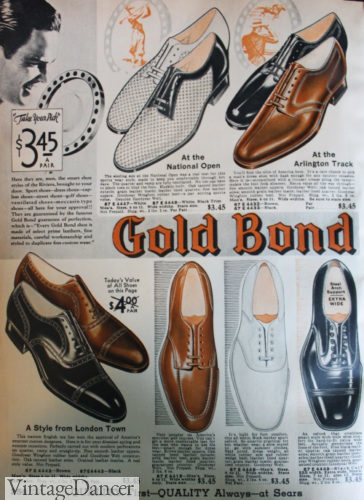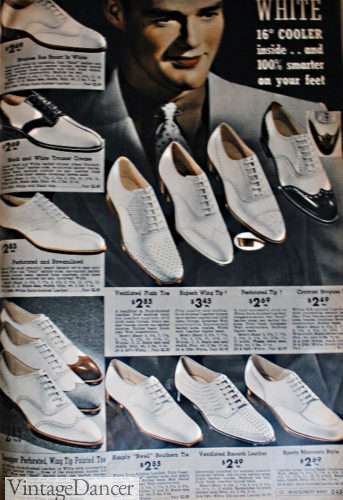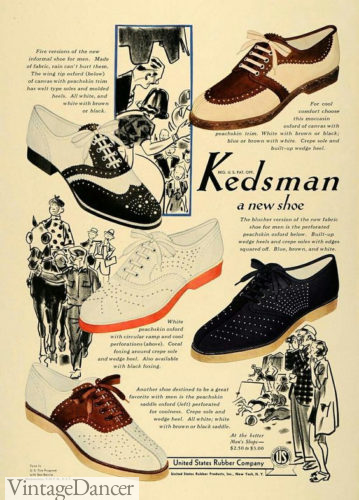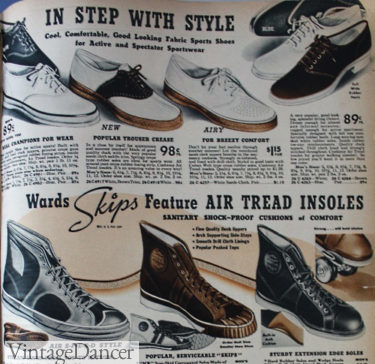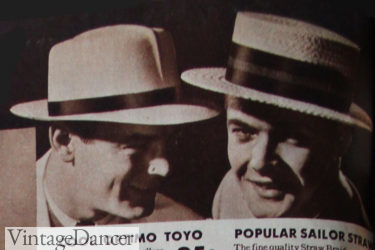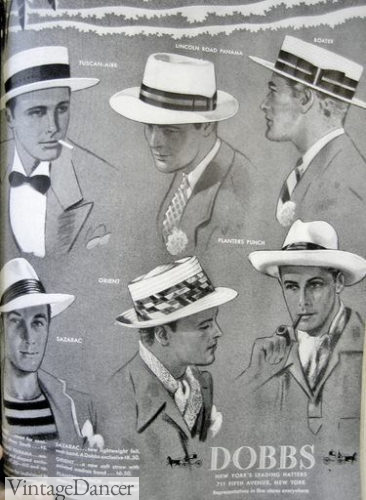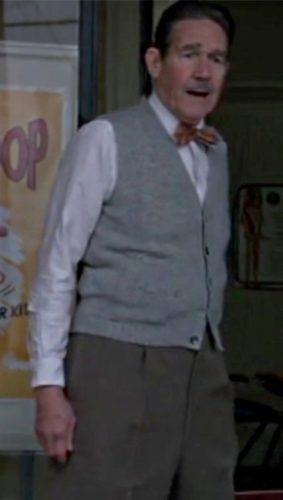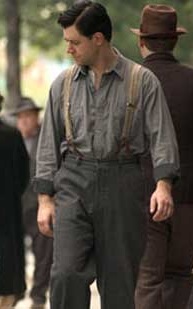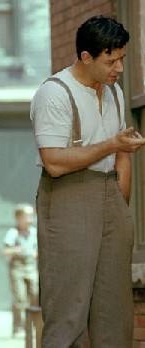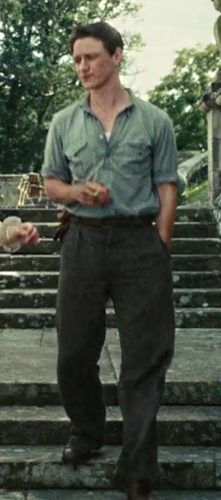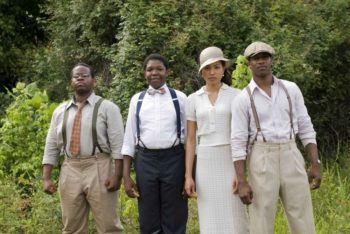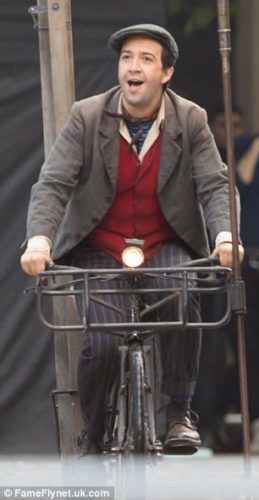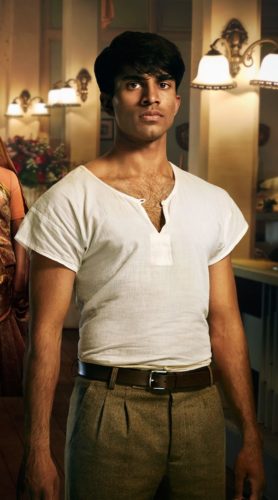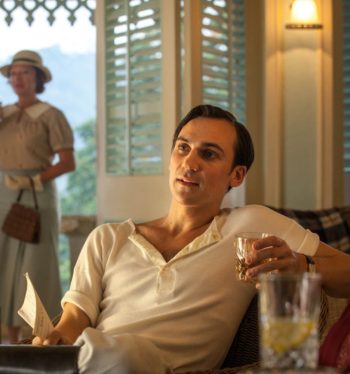As full weekends and reduced weekday hours became more common in the 1930s, so did the desire to get out of work clothes, business suits, and uniforms, and into something sporty and casual. A man’s time off became a time to dress for comfort and leisurely pursuits inspired by the same movie stars and rich folk who set the tone for business attire as well.
Stars vacationing on the Riviera or Palm Beach sported the latest fashion for summer which included short sleeve knit shirts (polo shirts), shorts, and swim trunks for the first time. These new designs were slow to catch on to the masses, yet the overall trend for lighter, more comfortable sporty and casual clothing continued to expand for all classes.
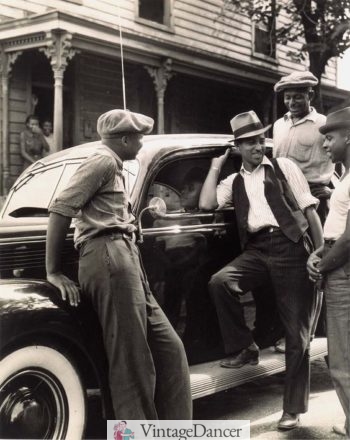
1938 Casual Style
Casual Men’s Sport Coats
Despite potentially high summer heat, men wore suits, sport coats, long sleeve shirts, and long pants all year. Only during certain activities (such as playing sports, vacationing at the beach, or relaxing at home) was “casual” clothing worn. That didn’t mean men were in stuffy grey 3 piece suits in the thick of summer, although that was an option (without a vest). Mismatched sport coats and trousers became the preferred semi-formal style for men.
- Brown sportcoat with grey check pants. Blue shirt, red bow tie, boater hat.
- Summer Fashion – Green Sportcoat or Blue Sweater Coat over Grey Trousers, Ivory Shirts, Neckt grey trousers, ivory shirts, necktie, tyrolean hat or flat cap.
Men’s 1930s sport coats were quite cool, colorful, and bold with the use of big patterns and unique textures. The fit was large with padded shoulders, wide notch or peak lapels, and a slightly curved jacket at the high waist. Large pockets provided plenty of room to hold a case of cigarettes, a cigar, pipe, hanky, and some money.
Patterned sport coats were paired with solid light pants in ivory, grey, khaki tan, blue, or white. Solid jackets paired equally well with patterned trousers. Different textures could be mixed as well. A brown tweed sport coat pairs with subtle striped brown trousers below. The mix of solid and patterned or textured clothing introduced a new casual style to otherwise formal attire.
- 1931 Green Sportcoat with Tan Trousers
- 1938 Casual Sport Coat Outfits
Men’s High Waisted, Wide Leg Pants
Most 1930s men’s trousers were quite wide compared to today’s slim-fitting trend. They came in solid colors as well as big plaids, checks, and windowpane that were more interesting and more casual than their dress pant siblings. In summer, white, ivory, light grey, and light tan were preferred over dark colors. Light wools were gradually being replaced by light flannels, linen, sailcloth, gabardine, and rayon blends. In fall/winter, the brown corduroy pant was a comfortable, soft, and casual pants option.
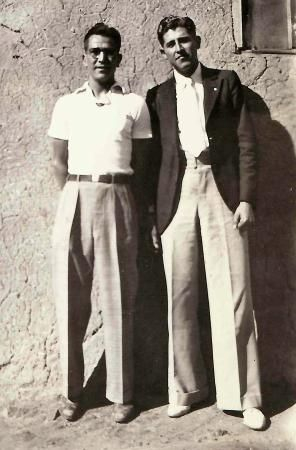
Casual Summer Pants Worn with a Polo Shirt (L) and Sportcoat over Hollywood Pants (R)
Trousers belted about 3 inches or so above the navel and hung down in long column-like shapes. The crotch was a deep drop to mid-thigh for ample room. Pant legs cuffed at the bottom for more casual wear, and were straight hemmed for more professional attire. A strongly pressed pleat down the center completed the look in the mid to late 1930s.
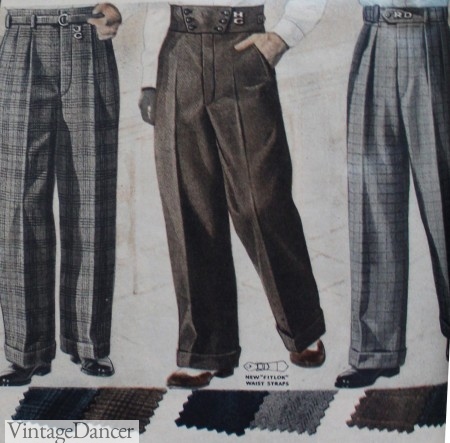
1937 Men’s Wide Leg Pants. “Hollywood” Waistband in the Center
The college kids set the fashion for men and inspired new styles seen in Hollywood movies. The wide “Hollywood” waistband appeared in the late 1930s and caught on with the young and trendy. It was not worn with a belt or suspenders.
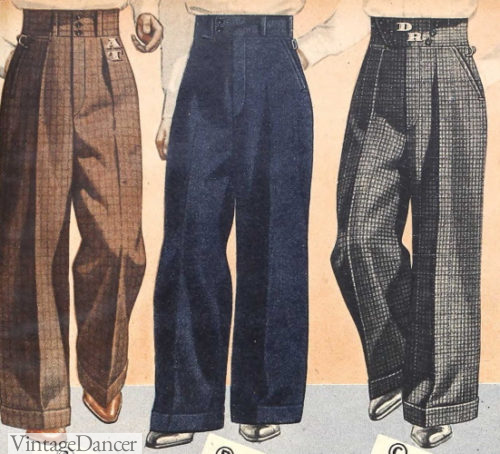
1938 Hollywood Waistbands
Most casual pants were worn with a belt. Suspenders were still worn by some older men or working classes who purchased hand-me-down clothing with suspender buttons already attached. Suspenders were not meant to be seen, only worn under a jacket, yet Hollywood movies love to costume men with suspenders over a work shirt and pants (often with belt loops, too).
- 1938 Summer Trousers for Casual and Dressy Attire
- 1938 Fall Winter Trousers
Blue jeans were usually sold as workwear for men. However, the popularity of TV stars and singing cowboys such as Gene Autry and Roy Rogers made Westernwear something city slickers could wear on the weekends — Levi’s blue jeans paired with a brightly colored silk cowboy shirt, shiny silver buckle belt, cowboy boots, and big western hat.
Learn more about men’s 1930s trousers, blue jeans, overalls, and plus fours.
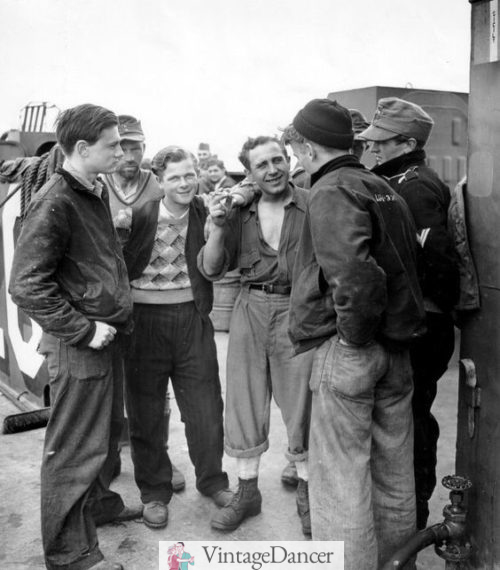
Young Men on the Job Wearing some Blue Jeans
Men’s Shorts
Tennis shorts appeared on the courts of colleges and communities in the 1920s, but didn’t go mainstream until British Tennis champion Bunny Austin wore a pair of white well-above-the-knee flannel shorts or “ventilated pants.”
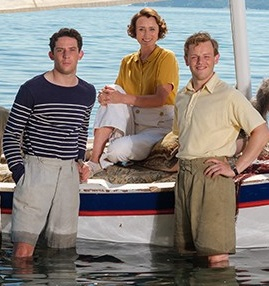
1936- Men in Shorts in The Durrells in Corfu miniseries
Knee length “walk shorts” were commonly worn in British ruled tropical colonies such as Bermuda, Jamaica, and the Bahamas. Americans copied these comfortable high waisted, straight leg shorts, making them the thing to wear on their own summer vacations. The length shortened up considerably for the bravest and trendiest of Americans. Common colors were light grey, white or ivory, and khaki tan (a nod to British Army officers of India).
- 1930s Men’s Shorts on a Tropical Riviera Vacation
Shorts found their way onto golf courses when made of very bright patterns, paired with knee-high socks and polo shirts. Fabrics moved away from smooth finishes to textured weaves and meshes that matched the variety of sports shirts.
1930s Plus Fours
A few traditional American men continued to wear knickers/breeches, called plus fours or plus sixties on the golf course or at the beach and resorts. They were exceptionally long and slightly more narrow, bagging more around the mid-calf than the ’20s versions. Lighter fabrics and bold prints made them more comfortable to wear in spring and summer. Paired with a shirt and tie, tall socks, a cap, and a pullover sweater, the look is a classic for British Royals.
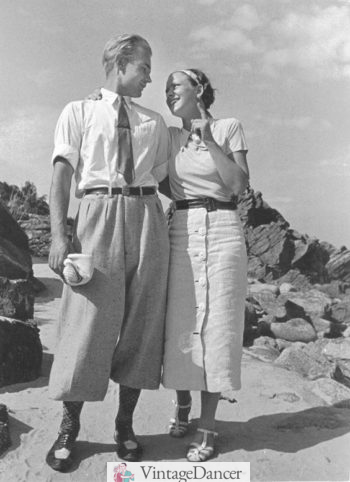
1930s Men’s Knickers Pants
Men’s Casual Shirts
While the classic button down dress shirt remained a staple in a ’30s man’s everyday wardrobe, a new casual shirt started to make headlines. The Polo shirt came into vogue, and they haven’t left the fashion world since. The ’30s versions could be an open V neck, zip up, corded lace up or single button with keyhole (Prince of Wales style) as well as multi-button traditional. A few polo styles experimented with the crew neck collar while many adopted the long and pointy spearpoint collar. Textures could be heavy knits, mesh weaves, “dishrag” cotton, peasant linen, ribbed cotton, terry cloth and other textured knits.
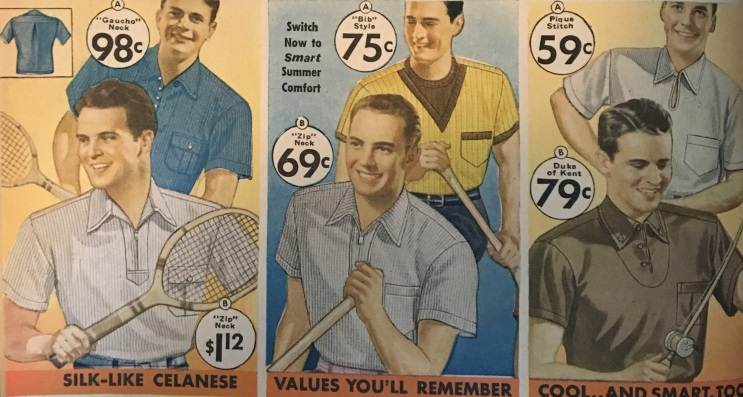
1937 Men’s Sporty Polo Shirts – (Upper Left) Gaucho Neck, (Upper Right) Prince of Wales Style
Sleeves and collars could be contrasting colors and textures, banded or open. A single chest pocket was common, as were pocketless polo shirts. Colors were usually solid natural hues but many came in stripes, diamond patterns, or two-tone combinations such as the yellow and brown below. For collared button-up models, a tie could be worn with a sport coat for a semi-formal occasion.
- Lace Tie Polo Shirts
- 1938 Polo Shirts
The Gaucho style short or long sleeve pullover shirt was made of linen or slubbed cotton, inspired by traditional shirts in South America. It featured loops rather than button holes, a wide fold out collar, ribbed cuffs, and a banded hem. It was to become extremely popular in the 1940s and 1950s. The 1930s version was sometimes called a sports blouse.
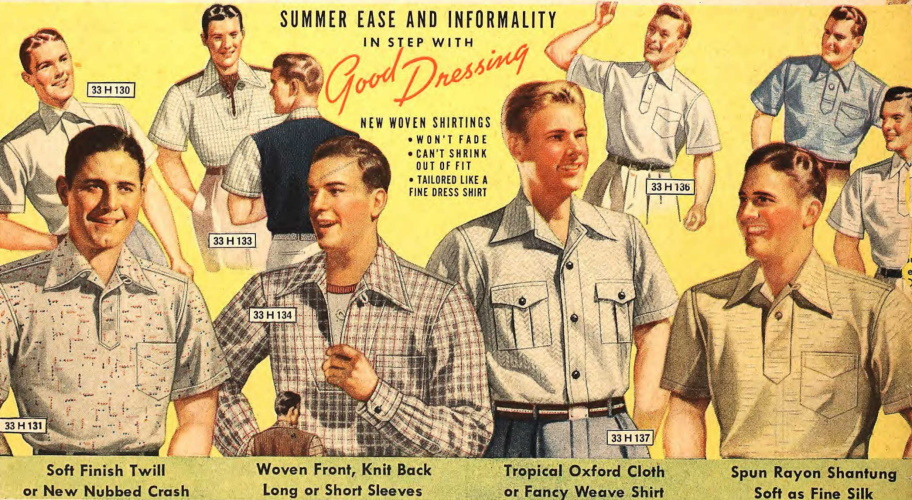
1938 Variety of Summer Casual Shirts (Gaucho in Upper Left)
Hawaiian print short sleeve casual shirts came into vogue by the late 1930s. These sport shirts featured colorful pineapples, coconut palms, and tropical flower prints. Most had a classic collar, while some featured the iconic spearpoint collar. The length was long enough to be worn untucked, but was still usually tucked into high waisted trousers. Buy vintage 1930s Hawaiian shirts on eBay.
- 1930s Hawaiian Shirt
Bush shirts were another new fad, although they had been around for many years. Indiana Jones explored tombs and caves in this style of shirt, as did real safari hunters and jungle adventurers. Bush shirts were white with short sleeves and had four patch pockets on the front. A wide buckle or tie belt was worn around the shirt at the high waist.
In 1936, the Guayabera shirt was copied from those worn by sugar planters in Cuba and brought to America. It was made of linen in natural beige, dark navy blue, brown, and yellow. This style of shirt is easy to find today and very comfortable in hot climates.
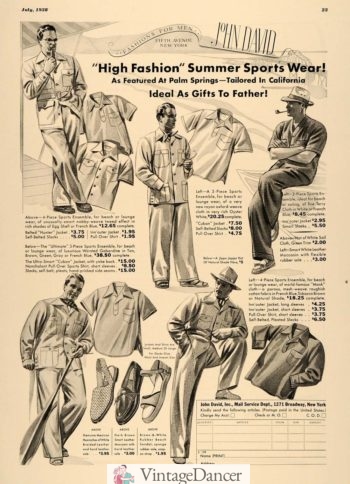
1938 John David Sport Shirts, Jackets (Cuban and Bush), Pants, and Shoes
Another similar shirt jacket is the Cuban jacket, which had four oversized pleated shirt pockets, wide collar, and a long sack fit. It and most casual shirts or shirt-jackets were paired with a silk scarf tied like a neck bandana or wrapped and stuffed inside the shirt like a cravat. The pop of bright scarf contrasted well with plain colored shirts. Here are a few ways to tie a neck scarf.
- Bush Skirt
Inspired by striped fishermen’s shirts on the French Riviera, the first T-shirt was born. Made of soft Egyptian cotton with wide blue or red stripes and a boat neck, it was usually long sleeve or elbow length, sometimes with a contrasting crew neck. Movie stars like Leslie Howard were frequently seen sporting striped shirts and wide leg linen trousers. Sleeves were eventually shorted up into the shirt length.
- Leslie Howard and Ingrid Bergman 1938 – Leslie Wears a Striped Short Sleeve T-Shirt
- Red Striped Boat Neck Shirt
By the end of the decade, the T-shirt was a weekend staple. White T-shirts were the most popular, sometimes with contrasting trim on the crew neckline, sleeves and breast pocket. Other color options were blue or yellow.
- 1939 polo shirt and T-shirt
- 1939 T-shirts with contrast trim
In winter, men turned to button down solid or plaid two pocket shirts. Wool weather shirts were made of wool, cotton, suede cloth, corduroy, gabardine, flannel, and mixed blends. There were summer versions, too, made of light silk, linen, or cotton in long sleeves. When the weather was hot, sleeves were rolled up to the arm to make them “short” and the neck was left unbuttoned to the mid-sternum.
- White Button Down Shirt and Corduroy Pants
- 1935 Men’s Work Shirt Casual Attire
- 1938 Plaid Shirts – Casual, Sport, Workwear
- 1936 Plaid Flannel Shirts
Men could wear dressy shirts in the same fashion, and often did. Casual dress shirts were more often patterned and in color. White based shirts were ideally worn for summer water sports such as sailing. Neckties were optional.
Learn more about men’s 1930s shirts.
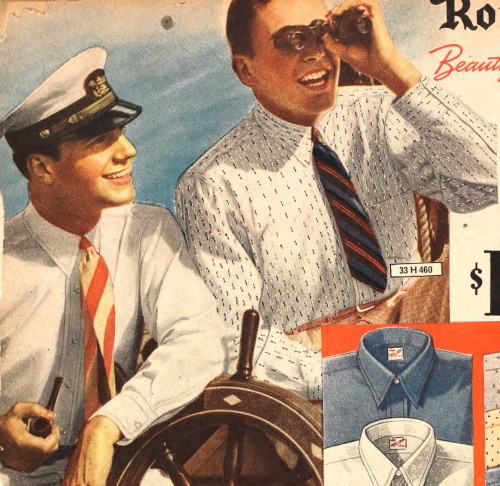
1938 Dress Shirts Worn for Casual Summer Sports
Men’s Sweaters, Cardigans and Vests
While sweaters were enjoyed mostly by the lower class, young men of the 1920s and the 1930s saw sweaters and sweater vests as a refined fashion element. Knitted crew neck, V-neck, shawl, and turtleneck pullover sweaters and button-up or zip up cardigan sweaters were a winter to spring staple.
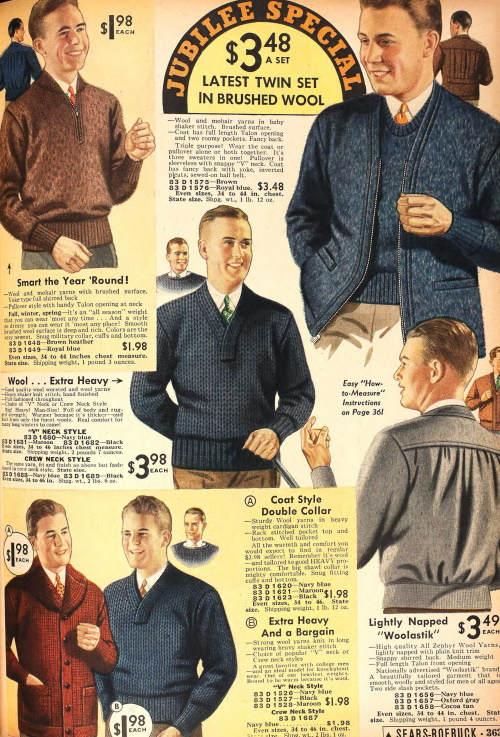
1936 Men’s Sweaters
Sportier versions featured two-tone colorblocking, belts, and zips instead of buttons. Wide ribbed bands, cuffs, and collars contrasted with a textured knit design on the body. Popular colors were tan, yellow, light blue, and white for spring sports. Fall and winter knits captured patterns such as argyle plaid and Fair Isle as well a solid navy blue, all shades of green, brownish red, and dark grey.
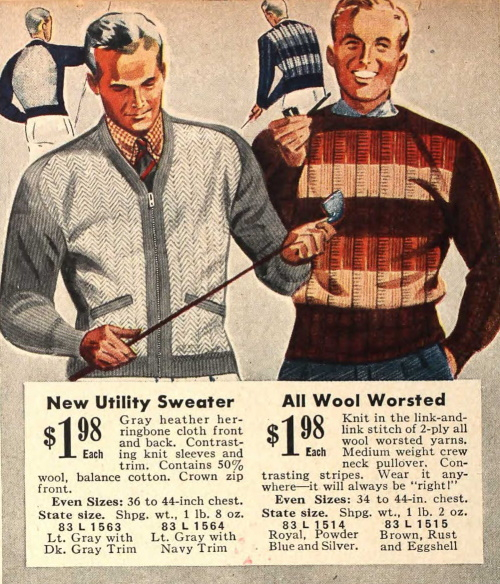
1939 Two-Tone Zip Cardigan and Striped Pullover
Housewives took to knitting their husbands a new sweater every winter– a perfect Christmas gift for the handsome ’30s man. Meanwhile, college kids purchased knitted sweaters with college initials and insignias featured on the front.
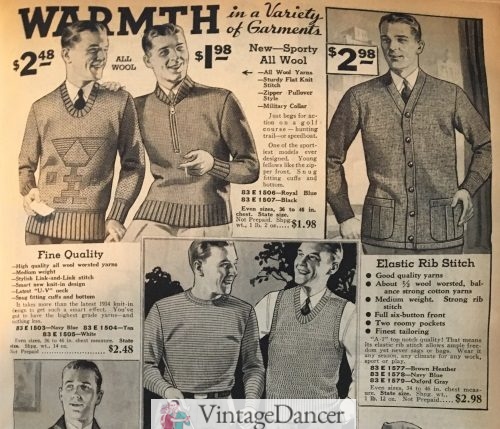
1937 Young Men’s Sweaters and Vests
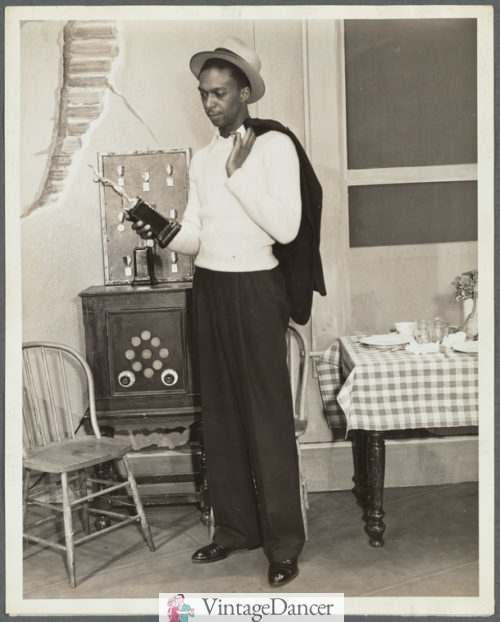
1937 Actor Maurice Ellis Wears a Pullover Sweater
Pullover sweater vests could be worn over dress shirts or casual polo shirt. They featured a wide ribbed bottom, oval neckline and a close fit around the arms. The bright colors added that springtime pop of color needed for an otherwise neutral outfit. Button down suit vests in the same cheerful colors were also an option, although usually worn with a sportcoat.
- 1933 Sweater Vest worn with Golf Clothes
- 1937 Neat Sweater Vest for Dressy Occasions
- Late 1930s Fair Isle Sweater Vest
- A Yellow Vest adds a Pop of Color to a Neutral Outfit (the Red Scarf Does Too)
In summer, the white cable knit pullover sweater or sweater vest with contrasting stripe on the V neck continued to be tennis and cricket uniforms. Paired with white shorts or long pants, the look is unmistakably vintage.
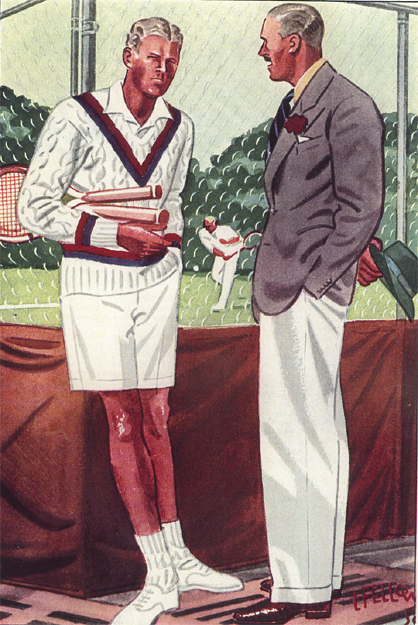
1930s Tennis Outfit with White Cable Knit Sweater with Striped Trim
1930s Men’s Jackets
The short jacket took inspiration from men’s aviation coats. Short leather jackets made of sheep or horsehide were worn for sports – horseback riding, motoring/motor biking, hunting – and as everyday styles for college kids. Black or brown were the choices for all leather. Some had an open bottom, some had a knit banded hem, and others featured a buckle belt to pull them in snug above the hip line. Grey, cream, champagne, and light tans were added in suede finishes. Wool torsos with leather sleeves later became known as the baseball jacket when made up in school or team colors.
- 1938 Wool Sport Jackets
- 1936 Men’s Casual Jackets
- 1930 Young Man in a Leather Jacket
- 1937 Leather Jackets
- 1937 Men’s Suede Sport Jackets
- 1938 Baseball Jackets
The all-wool short jacket mimicked the leather aviator jacket. Plaid was especially popular, but solid colors and the occasionally two-tone colorblocked jackets were options too. The back featured a half belt “sport back” or shirred back for a tighter fit. Two to four slit or zippered pockets on the front kept a neat flat appearance while providing some space to hold small items. The overall length ranged from 22-29 inches. Shorted jackets in lighter colors were favored in the south and west, while longer jackets with wool lining were popular in the northern regions.
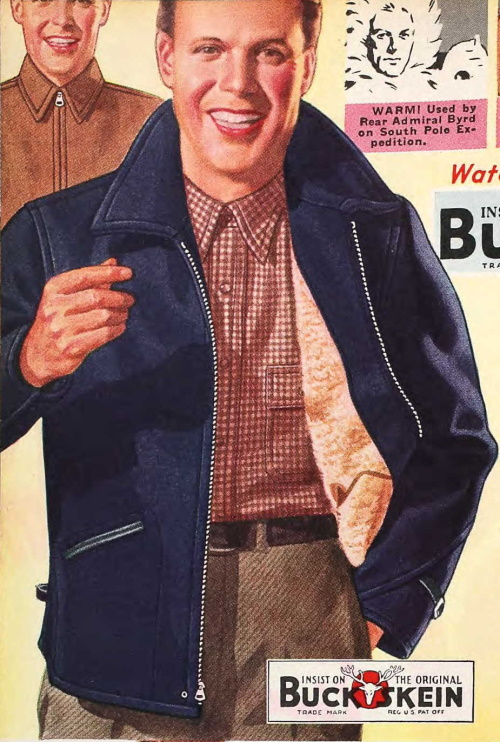
1936 Men’s Shearling Lined Wool Jacket with Casual Check Shirt, Belt, and Trousers
Heavy winter coats such as the plaid Mackinaw continued to be a crossover from workwear to casual wear. So did the sheepskin lined mid-length coat with oversized notch fur or shearling collar. These were frequently worn on college campuses by the young and wealthy. The outer layer could be moleskin, corduroy, or duck cloth.
- 1938 Mackinaw Jackets
- Franklin D. Roosevelt Jr, in a Shearling Coat (Colorized by AHumblePear) Late 1930s.
- 1936 Belted Fur-Lined Coats
- Corduroy Work/Casual Jacket and Pants Set
Raincoats were another casual option worn by all classes of men in spring or rainy climates. The shorter the coat, the more casual it was. Knee length was about as short as they came in the 1930s, with longer styles for more conservative dressing. Learn the history of the raincoat for women.
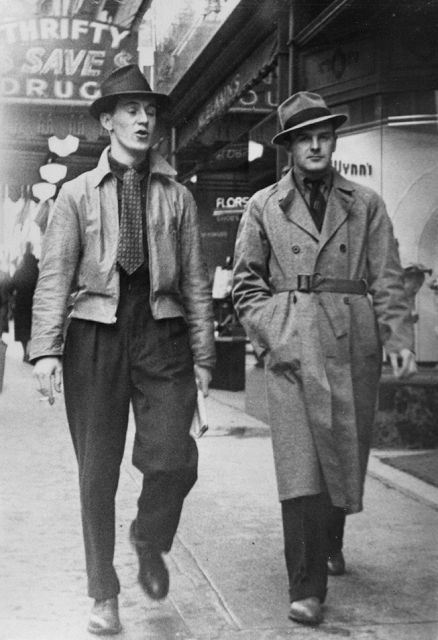
Short Leather Jacket and Knee-Length Raincoat
Men’s 1930s Swimwear
In the 1920s, swimwear for women and men made dramatic changes. In the 1930s, the beginning of the decade still embraced the one piece crab-back wool swimsuit, which looks a little like a modern day wrestling uniform. Large armholes, deep round necklines, an open back, and short shorts made the bathing suit minimal yet still modest. A two-piece look was achieved with a striped top and solid colored shorts with a belt.
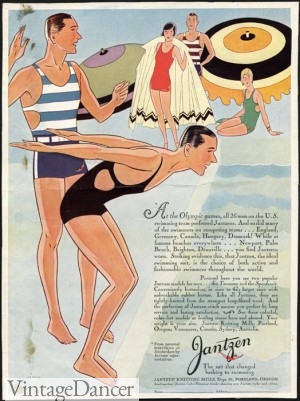
1930- Men’s Swimuits Were Getting Smaller, but Still an All-In-One Style
As with all other fashions in the 1930s, a well-built body couldn’t hide behind a tank top for long. Men’s swimsuits went shirtless. Now swim trunks, high-waisted shorts with a white webbed belt, were the new style. As the decade progressed, the trunks lost more leg coverage until they resembled underwear– or Superman’s briefs. Read more about the history of men’s swimwear.
- 1935 Old and NEw Style Men’s Swimsuits
- 1937 Swim Shorts (Briefs)
- Top and Bottom Swimwear Set
- 1939 With and Without Swim Top
With swim trunks being so skimpy, the need for a cover up top was critical. Beach robes made of flannel and terry cloth in solid colors or vertical stripes were the answer. Some had prints of tropical or nautical themes, which reminded viewers that they were for the beach and not the bedroom.
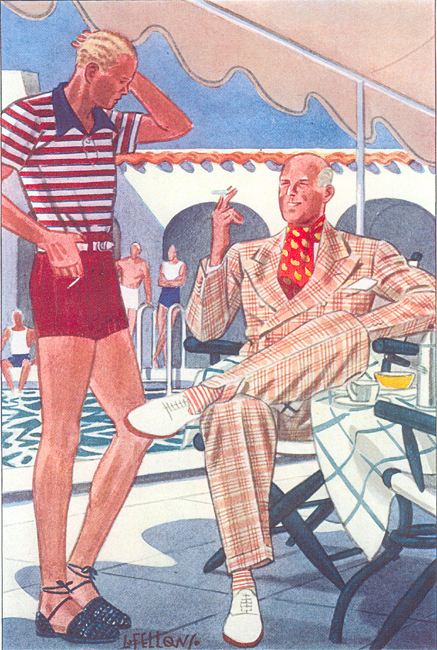
Swim Shorts and Striped Polo Shirt
Throwing on a striped T-shirt or polo shirt was an easier and cooler solution to the modesty dilemma.
Shop men’s vintage style swim suits and cabana sets.
Sunglasses
Men turned to sunglasses in tinted grey, green, or amber lenses to help protect eyes from the sun. Up until the mid-1930s, sunglasses were not viewed as fashionable. Most were round frames, just like eyeglasses, that either clipped onto regular glasses or were their own separate pair of tinted glasses. In 1937, the Ray-Ban aviator glasses were being marketed to sports players, but were quickly adopted by Hollywood stars. From then on, all sunglasses were designed with fashion in mind. Read more about the history of 1930s sunglasses.
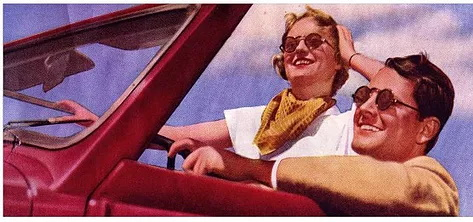
Round Sunglasses
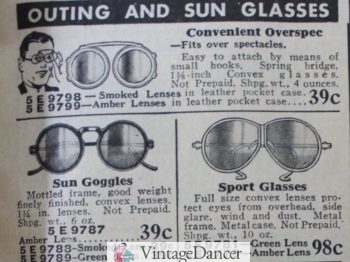
1934 Men’s Sunglasses – Clip-On, Round, Sport Shapes
1930s Men’s Casual Shoes
The difference between formal and casual shoes was minimal in the 1930s. A pair of brown, black, or white Oxfords could be worn with suits or casual trousers and a sport shirt. Two-tone shoes, black and white, brown and white, or grey on grey were considered “sportier” looking shoes, perfect for watching sports or wearing with casual outfits. Two-tone shoes, including saddle shoes, became popular on the golf course as well as with boys and teens.
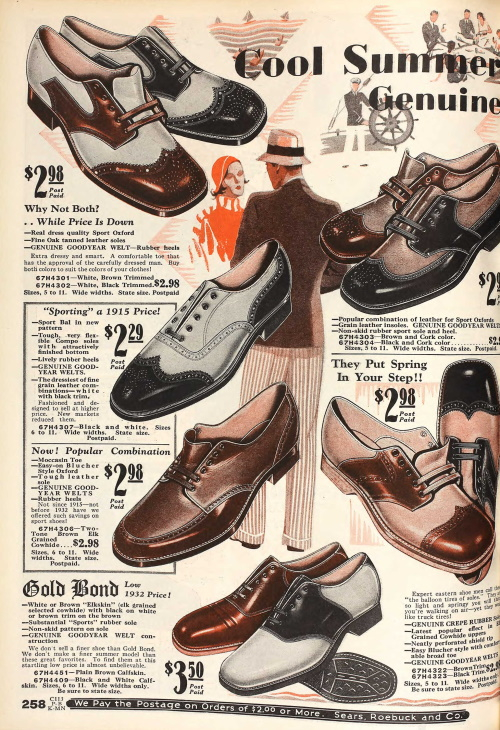
1932 Two-Tone Casual Shoes
Red rubber-soled white buckskin shoes were a fad for resort and casual dress. Small holes perforated all over some white buckskin shoes and were worn without socks. All kinds of leather and canvas Oxfords also featured perforated bodies or mesh weaves to allow for maximum airflow. These were worn year-round, except in wet weather.
- 1937 Dressy or Casual Summer Shoes
- 1934 White Summer Oxfords
Loungers were slip-on moccasins featuring a strap across the instep with a diamond cutout in the center. Weejuns were introduced in 1936, but it wasn’t until the 1940s and 1950s when teenagers inserted a penny into the cutout and called them penny loafers. Moccasin loafers with laces on top were called Norwegian front shoes and often came in brown and white combination, while the Weejun was a solid brown. These were mostly an upper-class shoe fad until the 1940s.
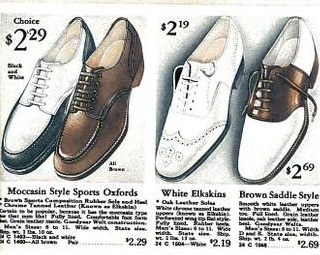
(L) Moccasin Top Two-Tone and Plain Shoes, (R) White Perforated Leather Wingtips and Saddle Shoes
Leather or crepe rubber sole sandals with leather straps crisscrossed over the foot formed a genderless summer shoe (think fisherman sandals). Mexican huaraches with multiple thin straps across the foot but only one strap around the heel were another popular beach shoe.
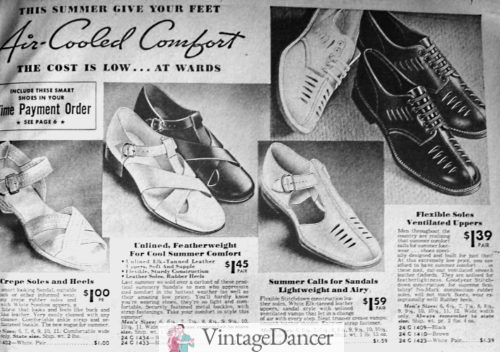
1938 Men’s Sandals
Espadrilles from the Basque country, with wide rope soles, were made for beachwear in bright canvas tops that laced up around the ankle (see them in the red swim short illustration further up the page).
Sports shoes like high top canvas Converse continued to be the athletic shoes for sports like Basketball. The canvas top and rubber sole ankle shoe were also worn for indoor and outdoor sports and casual summer days.
- 1938 Kedsman Sport Shoes
- 1938 Sport and Casual Shoes
Men’s Casual Hats
Felt hats were worn year-round, even in summer, and with all styles of dress from formal to casual. The trend for hatlessness was increasing however, especially in very casual settings, while vacationing, and with the younger set. The appeal of a suntan had a lot to do with not wearing a hat, at least for a few hours. When a hat was worn, it was usually a snap brim fedora type in felt or straw to match the season. Felt hats were usually light to dark grey with dark brown, tan, and green being nice alternatives.
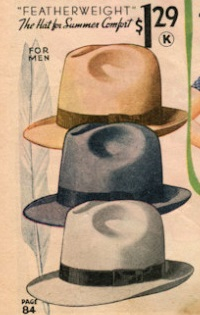
Summer Felt Hats, Fedora Hat, Snap Brim
The green Tyrolean hat (think Robin Hood) with a clipped feather at the back or side and a corded band was a casual sports hat with a comical personality. Rust brown, black, and chocolate brown were other options. The dark green shade found its way onto fedoras, pork pies, and caps. Green was the ultimate casual hat color.
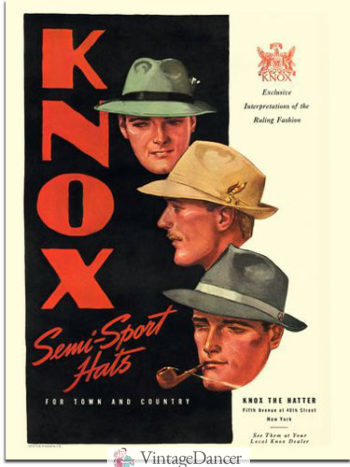
Knox Tyrolean style casual hats
Straw hats in the same shape as felt hats were worn in late spring and summer. Colors ranged from white, to tan, to light grey. The Optimo Panama (rolled crease down the center), sennit straw, and toyo continued to be favorites with vacationing upper classes. They came in narrow, medium, and wide brims, with the latter being the most practical. The round and flat top boater or sailor hat was a stylish hat for all classes in summer. It had a wide band with stripes matching a college, social club, or sport club’s colors.
The straw pork pie or telescope crown hat was the newest straw hat style with a low flat top and snapped down brim in the first half of the decade and a wider brim and back snapped up in the later years. The very wide planter hat (jipajapa) also had a slightly bowled flat top with rolled brim edges as did the leghorn hat. Summer straws came with perforated holes for breathability and a wide band in solid or striped colors.
- 1938 Optimo Panama Hat and Boater Hat
- Dobbs Straw Hats – Boater, Pork Pie, Boater, Fedora, Longhorn, and Plater Hats
Flat Caps, also knows as Ivy caps and newsboy caps among other names, became popular in the 1920s and remained popular throughout the 1930s. Everyone from young boys to working class men and casually dressed upper-class men wore caps. Tweed and Herringbone patterns in light colors were the most common caps. Checkered hats were a brief fad in the last years. Corduroy was another favorite material. Caps could be pieced together from 8 panels or a single “one piece” cap. 1930s men’s caps were quite wide and floppy compared to most caps found today.
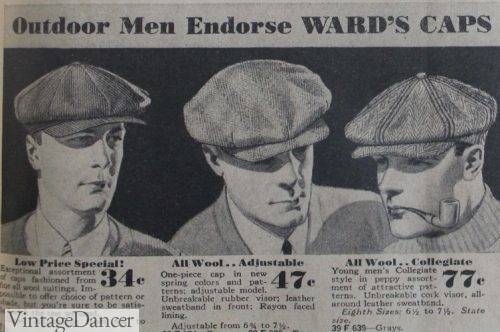
1933 Caps
Gallery: Movie Inspiration
Accuracy is not something that is often achieved in movies, but these costumes are a decent inspiration. (The use of suspender with pants that have belt loops bugs me.)
- Sweater Vest and Bow Tie in Hudsucker Proxy
- Working Class Shirt, Suspenders, and Trousers in Cinderella Man
- Short Sleeve Sport Shirt, Suspenders, and Trousers
- 1930s Rolled Sleeve Shirt, Belt, Trousers in Atonement
- Summer Casual in The Great Debaters
- 1935 Sportcoat, Red Vest, Neck Scarf in Mary Poppins
- Madras Shirt, Belt, Trousers
- Indian Summers Men’s Casual Fashion Knit Shirt
1930s Men’s Casual Outfit Ideas
Altogether, you can create a 1930s vintage casual look using reproduction (very few choices) or new clothing. Here are some outfit ideas:
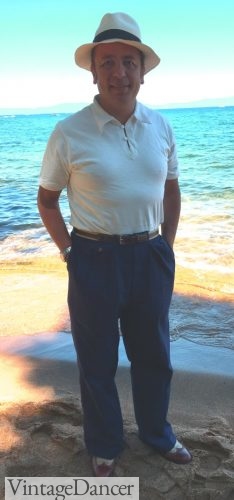
Oscar wears 1930s reproduction pants and polo shirt from Simon James Cathcart. His straw fedora hat and two-tone oxfords pull it all together.
- Simple. High waisted, wide leg trousers and a button-down shirt or polo shirt, belt, Oxford shoes, and a straw hat or floppy cap. This is simple and ideal for warm weather, but may not read vintage enough. The high/wide pants will help as well as choosing a textured polo shirt that isn’t the normal classic polo shirt you can buy anywhere. Look for textured knit, a zip up front or fold out collar to gain more of a 30s style. Shop shirts.
- Three pieces. Add a sportcoat and tie or scarf to the above look for something a little more dressy. You could add a bright colored vest or pullover knit vest to really stand out from the crowd. Consider wearing a felt hat (fedora or Tyrolian) or nice wide brim straw hat too.
- Tennis. The classic shirt or polo with pullover white sweater/sweater vest and either white shorts or long pants and white Oxfords is timeless yet easy to make today.
- Riviera. A blue and white or red and white striped shirt with white pants or shorts, belt, and shoes is another easy 30s casual look.
- Tropical. A Hawaiian shirt tucked into light pants and canvas casual shoes (like Keds) is great for summer. I hesitate to recommend his because it associated more often with the 40s and 50s. Instead, wear a guayabera shirt either tucked in or untucked for a more unique 30s look.
- Winter. A Fair Isle sweater or sweater vest, trousers, Oxfords, and a floppy cap is perfect for cool weather.
- Workwear casual – Roll up the sleeves of a cotton work shirt and pair with trousers, lace-up boots, flat cap and an unbuttoned vest for something casual for the working classes. Add a belt or suspenders. In winter, add a heavy knit sweater or zip up short plaid jacket or leather jacket.
See some of these and more 1930s men’s outfit ideas here.
- 1930s Men’s Outfit Inspiration | Costume Ideas
- 1930s Men’s Outfit & Clothing Ideas
- Accurate 1930s Car Show Outfits
- 1930s Men’s Workwear, Everyday Clothing
- Men’s Vintage Boating Outfits, Sailing Clothes
- Film Noir Costume Ideas
- Men’s Swing Dance Clothing, Vintage Dance Clothes
- 1930s Men’s Costumes: Gangster, Clyde Barrow, Mummy, Vampire, Frankenstein
Need help with your look? Just ask!
Read More
- What Did Men Wear in the 1930s?
- 1930s Men’s Workwear
- 1940s Men’s Casual Clothing
- Men’s Swimwear – 1930s-1950s Bathing Suit History
- 1930s-1950s Westernwear for Men and Women
Debbie Sessions has been teaching fashion history and helping people dress for vintage themed events since 2009. She has turned a hobby into VintageDancer.com with hundreds of well researched articles and hand picked links to vintage inspired clothing online. She aims to make dressing accurately (or not) an affordable option for all. Oh, and she dances too.
